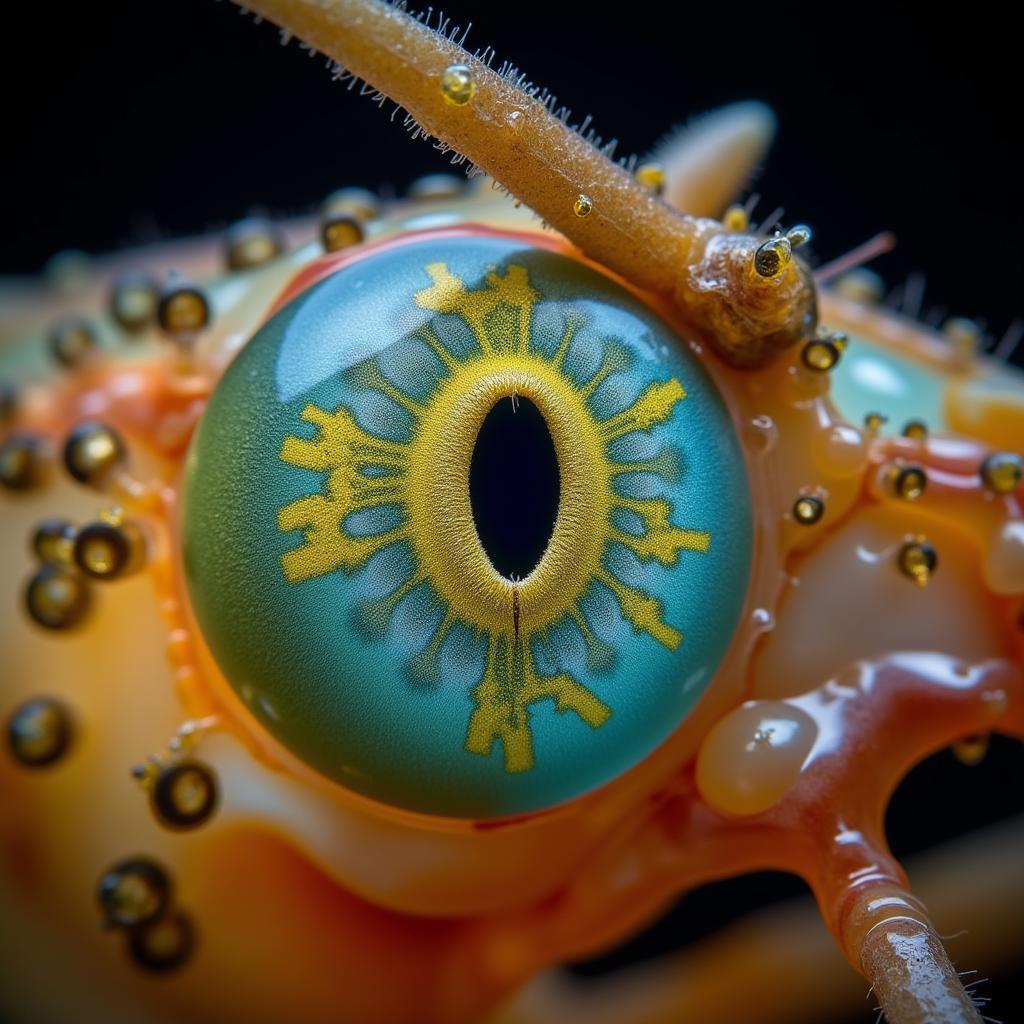Mantis shrimp are fascinating creatures known for their incredible visual abilities. The question “Can Mantis Shrimp See More Colors?” is a common one, and the answer is complex and intriguing. These underwater marvels possess a visual system far beyond human comprehension, making them a subject of ongoing scientific study.
Mantis Shrimp Vision: A World Beyond Human Perception
Unlike humans, who have three types of color receptors (red, green, and blue), mantis shrimp boast an astounding 12 to 16 types of photoreceptors. This raises the question of whether they perceive a broader spectrum of colors than we do. While they have more photoreceptor types, it’s not quite as simple as seeing “more” colors. Research suggests that their visual system processes color differently. Instead of mixing color information like humans, they may recognize distinct spectral bands as individual colors. This allows them to differentiate subtle shades and patterns invisible to us, but it doesn’t necessarily mean they see a rainbow we can’t even imagine. Think of it as a different way of processing color information, rather than simply seeing a larger range of hues. This unique vision gives them a significant advantage in their underwater world, especially for hunting and communication.
 Mantis Shrimp Eye Structure: A Complex System
Mantis Shrimp Eye Structure: A Complex System
How Many Colors Do Mantis Shrimp See?
The exact number of colors a mantis shrimp can perceive is still debated among scientists. While they possess 12-16 photoreceptor types, the way they process this information is still not completely understood. Research has shown that mantis shrimp don’t seem to discriminate between colors as well as humans, despite their numerous photoreceptors. This suggests that their visual system is optimized for other aspects of vision, like recognizing polarization and quickly detecting movement, rather than simply discerning between a vast array of colors. This specialization helps them thrive in their vibrant coral reef habitats. So, while they may not see “more” colors in the way we understand it, their vision is far more complex and adapted to their specific needs. Similar to [how many colors do you see], it’s not just about the quantity, but also the quality and type of color perception.
The Science Behind Mantis Shrimp Color Vision
The science behind mantis shrimp vision is a fascinating area of ongoing research. Their photoreceptors are arranged in specialized structures called ommatidia, similar to those found in insects. Each ommatidium contains multiple photoreceptors, each tuned to a different wavelength of light. This intricate system allows them to analyze light in ways we can only begin to understand. For instance, they can detect polarized light, which is invisible to the human eye. This ability allows them to see hidden prey and navigate complex underwater environments.
Do Mantis Shrimp See Ultraviolet Light?
Yes, mantis shrimp can see ultraviolet light. Some of their photoreceptors are sensitive to wavelengths in the ultraviolet spectrum, which further expands their visual range. This ability may play a role in communication and recognizing potential mates, as some species have markings visible only under UV light. Just like [what colors do ducks see], their visual spectrum extends beyond what humans can perceive, adding another layer to their unique perception of the underwater world.
Why Do Mantis Shrimp Have Such Complex Eyes?
The evolutionary pressure driving the development of such complex eyes in mantis shrimp is likely linked to their lifestyle. They are active hunters, relying on their vision to spot prey and avoid predators in the bustling coral reef ecosystems. Their ability to detect polarized light and quickly recognize movement gives them a significant advantage in this environment. Furthermore, their complex vision may also play a role in communication and mate selection, as some species exhibit vibrant color displays during courtship rituals. Similar to [what color is a shrimp], the coloration and visual capabilities are crucial for survival and reproduction.
 Mantis Shrimp in Coral Reef Habitat
Mantis Shrimp in Coral Reef Habitat
Conclusion: A Unique Perspective on Color
Mantis shrimp vision, while not necessarily seeing “more” colors in the way we might initially think, is undoubtedly remarkable. Their unique visual system, with its numerous photoreceptors and specialized structures, provides them with a rich and detailed perception of their underwater world. It allows them to see polarized light, quickly detect motion, and likely perceive color in a way entirely different from humans. This incredible adaptation demonstrates the diversity and complexity of the natural world. As we continue to study these fascinating creatures, we gain a deeper understanding of the different ways organisms perceive their surroundings. Remember that while we may be limited in our own color perception, the world is full of vibrant hues and patterns waiting to be discovered, even if through the eyes of a mantis shrimp.
FAQ
- Do all mantis shrimp species have the same number of photoreceptors? No, the number varies between species, generally ranging from 12 to 16.
- How do mantis shrimp use polarized light vision? They use it for hunting, navigation, and communication.
- Are mantis shrimp colorblind? No, but they process color differently than humans.
- What is the purpose of ommatidia in mantis shrimp eyes? Ommatidia are the individual units that make up the compound eye, each containing multiple photoreceptors.
- Can humans see what mantis shrimp see? No, we lack the necessary photoreceptors and neural processing capabilities.
- Why are mantis shrimp eyes so important for their survival? Their eyes enable them to hunt effectively, avoid predators, and navigate their complex environment.
- How do mantis shrimp see movement? Their specialized visual system allows them to detect even the slightest movements with remarkable speed and accuracy.
You might also be interested in these related articles: [do pigs see in color] and [what is the relationship between color and wavelength for light].
Need help with color selection or design? Contact Color Box Hanoi: Phone: 0373298888, Email: [email protected] or visit us at 86 Cau Giay, Hanoi. Our customer service team is available 24/7.
